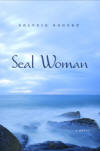Seal Woman
In Seal Woman, a historical novel by native Icelander Solveig Eggerz, Charlotte is a German wife and mother fleeing war-torn Berlin and the ghosts of her memory. One of more than 300 people responding to an ad for “strong women who can cook and do farm work” in Iceland, Charlotte hopes to live in a land without war memories – one she hopes will prove a refuge from the difficult recollections of her missing Jewish husband and their daughter.
In Seal Woman, a historical novel by native Icelander Solveig Eggerz, Charlotte is a German wife and mother fleeing war-torn Berlin and the ghosts of her memory. One of more than 300 people responding to an ad for “strong women who can cook and do farm work” in Iceland, Charlotte hopes to live in a land without war memories – one she hopes will prove a refuge from the difficult recollections of her missing Jewish husband and their daughter.
With wit, precision, the ring of authenticity and an arsenal of emotional truths, Eggerz weaves her native lore into the fabric of the novel. Seal woman derives from Icelandic legends revolving around a seal, or selkie, who transforms herself into human form. While human, the seal woman falls in love, marries and has human children, but in time she must return to her aquatic form to rejoin her pups in the ocean. It is not an easy decision for her to make, and she may feel torn for the rest of her life.
For Charlotte, the seal woman holds special significance. Her strong-willed artist husband, the son of a prominent department store family, is not exempt from the hatred propagated under Hitler’s regime. After he responds to a letter summoning him to a concentration camp, the decision Charlotte makes to protect her daughter will be one that roils within her across oceans and decades. She has to remind herself: “The hillside was better, better than the Germany she’d left after the war was finally over – no work, nothing to eat, the best people dead or gone.”
Missing her native, pre-WWII Berlin is a constant for Charlotte. Not knowing what has become of her daughter while attempting to learn the strange language and customs of Iceland weighs on her always. But there are unexpected gifts in the strange tundra.
The family she starts with, the farmer of Dark Castle, becomes her reluctant future. Like the seal woman, Charlotte is torn between her past and present. The sea is a means of transport, escape or certain death. As such, its transformative potential is as great as the conductive powers of water.
Transformation is not always a process people go through willingly; sometimes it happens because it has to. Even before the war, Charlotte and Max, both painters, know this through the practice of their craft. With the needless devastation of cultures, ideas, futures and families happening all around them to an unprecedented degree, they struggle with how to respond to a body politic that forces itself on its people.
There is a time when Charlotte and Max are painting, literally, in direct response to what is happening outside their door: “On the Kudamm they passed broken windows of Jewish stores, places where Jews had been beaten up. After that, Charlotte set up her easel in Max’s studio. In yellow, red and blue, she painted the police chasing the demonstrators over the square and the dead woman.” It is an unfortunate fact that uncountable lives, minds and works of art and creation were smothered in eternal silence by the megalomaniac hatred of Hitler’s deteriorated mind, and Eggerz paints the picture of this devastation and its far-reaching effects vividly. She later writes of the creative process, a way in which the artist can concretize and transfer emotional unrest: “She was learning that a painter did not absorb pain directly but broke it down into parts, integrating it gradually into his soul, often blending it with his own pain, then giving it back – in oil – transformed.”
Eggerz’s choice of subject matter is still very much in the worldwide social conscience. She masterfully weaves the complex historical themes into a novel about one woman’s struggle with change, identity, family and acceptance so that it speaks to the experiences of many, bringing home what it must have been like for them. The ending, while not what the reader wants or expects, is one that does justice to the unfortunate reality of the many lives impacted by the Holocaust. Charlotte is served many unwanted decisions that will linger much longer than the time it takes to fill a cattle car.





